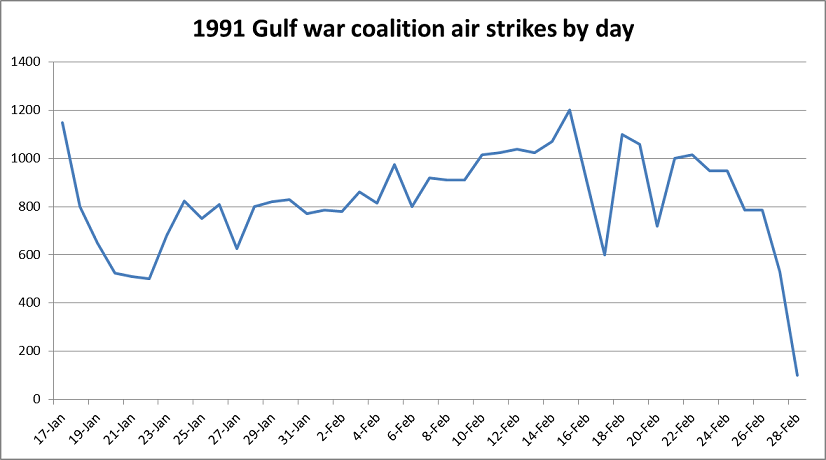Graph of the week—western air power and the strikes in Iraq
Posted By Andrew Davies on December 17, 2014 @ 06:00
With the launch of ASPI’s Strike from the Air paper [1] yesterday, I thought it was worth looking at some data from both the current campaign and the now well-documented 1991 Gulf War air campaign. There are a couple of interesting conclusions that can be drawn.
First, the raw numbers of the coalition air campaign against targets in Iraq in the 43 days of Operation Desert Storm. Redrawn from the 1993 Gulf War Air Power Survey [2] (PDF) by Thomas A. Keaney and Eliot A. Cohen, Figure 1 shows the number of airstrikes by day over a 43 day period from the commencement of hostilities.
Over 42,000 strikes were flown by coalition fixed wing aircraft—in addition to the many hundreds of cruise missiles launched from ships and submarines. Targets included ‘strategic centres’, facilities and platforms that could contest coalition sea and air control (especially the Iraqi Air Force and its aircraft in hardened shelters) and the Iraqi Army. In addition, coalition aircraft flew between 300 and 500 air-to-air sorties each day. For its part, the Iraqi Air Force managed almost 120 sorties on day one, and was effectively out of action by day 14, although sporadic activity continued for another couple of weeks.
The strategic targets included command, control and communication nodes, the Iraqi leadership, WMD facilities and key civilian infrastructure such as electric power, bridges and railways (averaging about 200 strikes per day). But the Iraqi Army received the lion’s share of the coalition effort, with no fewer than 23,430 strikes against ‘Iraqi surface forces’.
The effect on Iraq’s ground forces was, as might be expected, devastating. Keaney and Cohen quote one Iraqi veteran of the Iraq-Iran war of the 1980s who observed that his brigade suffered ‘more damage in 30 minutes than it had in eight years in the previous war’. As a result of early heavy losses and the enduring threat of air attack, the Iraqi Army lost any capacity for initiative, including the ability to withdraw from the Kuwait theatre. It resorted to constructing more berms and digging deeper for defence from air strikes. In short, coalition air power neutralised the Iraqi Army as an effective fighting force.
Now let’s look at the data from the ongoing air campaign against ISIL. In the first 43 days of this campaign commencing 8 August, the total number of strikes was just 167, compared to the 42,000 in 1991. The total number of strikes flown against ISIL over the past four months is now just a little over 1,200—the number flown on 15 February 1991.
At an estimated strength of between 20,000 and 30,000 [4] and possessing few armoured vehicles, ISIL is a small and poorly-armed force in comparison to the Iraqi Army of 1991 (around 500,000 troops with thousands of tanks, armoured personnel carriers and artillery pieces—all of which were candidates for strike operations) But the scale of the discrepancy is also probably indicative of the amount of air support that’ll be mobilised in support of Western troops on the ground as compared to other circumstances.
Like the Iraqi Army before it, ISIL’s already learning not to concentrate its forces and to minimise its exposure to air attack as much as possible. Its strategy is to keep close to civilian populations, relying on coalition rules of engagement to constrain further strikes. So what we have now is something of a stand-off. The coalition can’t isolate ISIL and destroy it, but the extremist group can’t operate as a coherent force of any size, making dramatic advances and the swift taking of major centres like Mosul unlikely in the future. Still, it can slowly infiltrate other areas and, like the Iraqi insurgency that followed the succession of large scale operations in the 2003 war, it can operate as a guerrilla force, making the governance of Iraq difficult.
The above comparison with previous coalition air campaigns suggests that the current low rate of effort is unlikely to stretch coalition forces. Essentially, the United States and its partners can keep up a campaign against ISIL for as long as it continues to operate as a military force. In that sense, ISIL can’t win, at least via a conventional military victory. The flip side is that it also can’t really lose its existing gains while coalition operations are constrained to air strikes only, and then only in circumstances where collateral casualties are unlikely. Air power reduced the 1991 Iraqi Army to an ineffective fighting force, but ultimately boots on the ground dislodged it. In the absence of a ground intervention, the most likely scenario in the near future is a continued slow degradation of ISIL as an ‘army’, but with no real change in the overall situation.
Andrew Davies [5] is senior analyst for defence capability and director of research at ASPI. Graph courtesy of Andrew Davies.
Article printed from The Strategist: https://www.aspistrategist.org.au
URL to article: https://www.aspistrategist.org.au/graph-of-the-week-western-air-power-and-the-strikes-in-iraq/
URLs in this post:
[1] Strike from the Air paper: https://www.aspi.org.au/publications/strike-from-the-air-the-first-100-days-of-the-campaign-against-isil
[2] Gulf War Air Power Survey: http://www.afhso.af.mil/shared/media/document/AFD-100927-061.pdf
[3] Image: http://www.aspistrategist.org.au/wp-content/uploads/2014/12/1991-Gulf-War-coalition-air-strikes.png
[4] estimated strength of between 20,000 and 30,000: http://www.telegraph.co.uk/news/worldnews/northamerica/usa/11091190/CIA-says-number-of-Islamic-State-fighters-in-Iraq-and-Syria-has-swelled-to-between-20000-and-31500.html
[5] Andrew Davies: https://www.aspi.org.au/about-aspi/aspi-staff/senior-analysts/andrew-davies
Click here to print.
